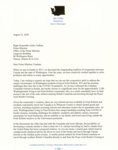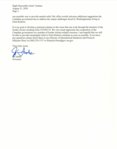

(Ed. Note: This article includes information previously published online in August 6 All Point Bulletin article and has been updated with further developments for print.)
Governor Jay Inslee is the latest to ask that federal border officials from the United States and Canada come up with a plan to alleviate the isolation of Point Roberts residents.
In an August 21 letter to Canadian Prime Minister Justin Trudeau, Inslee wrote, “Washingtonians living in Point Roberts face unique hardships resulting from COVID-19 border closures, including challenges to students’ academic and athletic careers, increased uncertainty for local businesses, and an inability to see family and loved ones living outside the Point Roberts enclave.”
Inslee is suggesting a transit pass system similar to the one recently announced for Americans traveling through Canada to get to and from Alaska. On July 30, the Canada Border Services Agency (CBSA) announced new rules for travelers transiting on non-discretionary trips, including checking in when they leave and re-enter Canada and a hang tag to attach to their rearview mirror for the duration of the trip.
As of August 26, the governor had yet to hear from Trudeau. “While we have not yet had an official response from the office of the prime minister, the governor will be speaking with Canada’s ambassador to the U.S. on Friday,” said Mike Faulk, the governor’s deputy director of communications, in response to a query from the All Point Bulletin. “The Seattle consulate general has also been in contact with us on the Point Roberts issue. In addition, we have been in contact with Premier Horgan’s office in Victoria in this regard,” Faulk added.
State senator Doug Ericksen and representatives Luanne Van Werven and Sharon Shewmake have also called upon federal elected politicians to intercede with border authorities to relax restrictions on travel by Point Roberts residents. Their letter follows ones from county mayors and officials, Point Roberts fire chief Christopher Carleton and others.
The letter was addressed to U.S. senators Patty Murray and Maria Cantwell and U.S. representatives, Suzan DelBene, Rick Larsen and Cathy McMorris. Acknowledging the challenging nature of the pandemic, the letter pointed out that Point Roberts “is a unique place facing disproportionate hardship,” adding, that residents “rely heavily on resources and services provided in Canada or mainland Whatcom County including food and groceries, health care visits, and even employment opportunities. With the current border crossing restrictions, Point Roberts residents continue to struggle.”
The letter asked that the recipients use their positions “as U.S. Senators and Congressmembers to engage with our U.S. Department of Homeland Security and Customs and Border Protection to negotiate with the Canadian government, Province of British Columbia, and Canada Border Services Agency. We seek greater clarity and flexibility in our current border crossing agreement in addition to including specific provisions addressing the unique needs of Point Roberts and our constituents.”
Point Roberts is not the only border community stuck in a similar situation. The small town of Hyder, Alaska, population 63, relies on its Canadian counterpart of Stewart, B.C., population 425, for its fuel, groceries and other necessities of life. An August 6 Vancouver Sun article reported the two towns have formed a Hyder Stewart Action Committee to petition federal, provincial and state governments in both countries.
“We want the government to say Hyder and Stewart meet all the criteria to be officially recognized as an integrated transborder community,” said Carly Ackerman. “And that residents of Hyder and Stewart can travel over the border without the mandatory 14-day quarantine,” reported the Sun.
The town of Hyder can only be reached by the rest of Alaska by flying or by road from B.C. The vast majority of visitors enter from B.C.
The border situation appears to be different for residents of the Northwest Angle in the Lake of the Woods, Minnesota. According to Joe Henry, executive director of Lake of the Woods Tourism, residents are able to go back and forth to the rest of Minnesota as long as they show proof of residency at the Canadian border crossing. Residents have to drive around 45 miles through Manitoba to make the trip.
Economically, however, the situation appears identical to Point Roberts in that outside visitors are mostly unable to travel to the Northwest Angle. The region is known primarily for its fishing and, to a lesser extent, its hunting and its 12 lodges and ancillary businesses are struggling with no customers, most of whom come from the states. “We estimate there is 10 percent occupancy at the lodges,” Henry said. He has been reaching out to Whatcom County tourism and government officials in an attempt to create a coalition seeking aid from the federal government. He has also contacted state and federal politicians in his neck of the woods such as U.S. senator Amy Klobuchar to make them aware of the dire straits his area is experiencing. “Some of the lodges could survive the loss of the summer season but if the border closure extends into the ice fishing season, there’s no telling what will happen,” he said.
Also suffering mightily from the border closure is Campobello Island in New Brunswick immediately adjacent to Lubec, Maine. The only way to access the island by road is through Lubec and consequently, both communities are hurting from a lack of traffic. Whale watching tours from Lubec have been hampered by the fact that the whales are most commonly found in Canadian waters, which U.S. boats cannot enter. Like Point Roberts, many residents have family in the other country and are unable to visit each other.
There are signs that the CBSA is increasing its scrutiny of Point Roberts residents traveling between the Point and the mainland.
The U.S. and Canadian border authorities share entry and exit information and residents have reported being questioned if they have stopped anywhere enroute after taking an inordinate amount of time to make the 35-minute drive.
One person reported that she was given permission to transit through to take her dog to the vet. When she arrived at the U.S. border, the officer mentioned the vet and, peering into the back seat, asked her how her dog was feeling.
Comments
No comments on this item Please log in to comment by clicking here